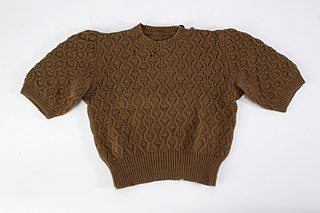 W
WThe ceinture fléchée [sɛ̃tyʁ fleʃe] is a type of colourful sash, a traditional piece of French-Canadian clothing linked to at least the 17th century. The Métis also adopted and made ceintures fléchées and use them as part of their national costume. French-Canadian and Métis communities share the sash as an important part of their distinct cultural heritages, their cultural distinctions, their nationalities, their national costumes, their histories and their resistance. While the traditional view is that the ceinture fléchée is a French-Canadian invention, other origins have been suggested as well. According to Dorothy K. Burnham who prepared an exhibit on textiles at the National Gallery of Canada in 1981, and published an accompanying catalogue raisonné, this type of finger weaving was learned by residents of New France from Indigenous peoples. It is believed that French settlers-habitants were influenced and inspired by "Wampum Belts" and learned specific finger-weaving patterns from Indigenous Peoples of the Eastern Woodlands. With European wool-materials, the syncretism and unification of French and Indigenous finger-weaving techniques resulted in the making of Arrowed Sashes. L'Assomption Sash is the oldest known sash design; produced by French habitants or artisans in Québec.
 W
WA guernsey, or gansey, is a seaman's knitted woollen sweater, similar to a jersey, which originated in the Channel Island of the same name, sometimes known as a knit-frock in Cornwall, especially Polperro.
 W
WTraditionally, a jersey is an item of knitted clothing, generally made of wool or cotton, with sleeves, worn as a pullover, as it does not open at the front, unlike a cardigan. It is usually close-fitting and machine knitted in contrast to a guernsey that is more often hand knit with a thicker yarn. The word is usually used interchangeably with sweater.
 W
WA karakul hat, also called a Jinnah cap in Pakistan, is a hat made from the fur of the Qaraqul breed of sheep. The fur from which it is made is referred to as Astrakhan, broadtail, qaraqulcha, or Persian lamb. The hat is peaked, and folds flat when taken off of the wearer's head.
 W
WA kilt is a type of knee-length non-bifurcated short dress with pleats at the back, originating in the traditional dress of Gaelic men and boys in the Scottish Highlands. It is first recorded in the 16th century as the great kilt, a full-length garment whose upper half could be worn as a cloak. The small kilt or modern kilt emerged in the 18th century, and is essentially the bottom half of the great kilt. Since the 19th century, it has become associated with the wider culture of Scotland, and more broadly with Gaelic or Celtic heritage. It is most often made of woollen cloth in a tartan pattern.
 W
WKnitting is a method by which yarn is manipulated to create a textile or fabric; it is used in many types of garments. Knitting may be done by hand or by machine.
 W
WShearling coats are made from processed lambskin, sheepskin, or pelt. This "shearing" process creates a uniform depth of the wool fibers for a uniform feel and look. Shearling coats and garments are made from pelts by tanning them with the wool of uniform depth still on them. The result is a soft, natural fleece material that is heavy due to thickness of outer skin and degree of fur on the inside, which is quite dense. The length of the sheep fur can be fairly long, but it is typically cropped short to about two inches or five centimeters. Most find these coats to be extremely comfortable and warm. Due to the high quality and uniqueness of shearling, coats and garment are considered luxurious. Sheepskin and Shearling are synonymous. The outer must be sheepskin to be Shearling on the inside.
 W
WThe šubara is a type of traditional male winter hat used by the Serbs in folk attire. It is in a conical or cylindrical shape predominantly in black colour, because of the black lamb/sheep fur (woollen). It is a traditional peasant hat used in harsher and colder times.